-

<p>This striking embroidery is emblazoned with the images of the Eight Daoist Immortals, from right to left: Han Xiangzi, Cao Gaojiu, Lan Caihe, and Li Tieguai, with Shoulao, the God of Longevity (not one of the Eight Immortals) in the center, then continuing on the left with Zhang Guolao, Zhongli Quan, Lü Dongbin, and He Xian’gu (the only female immortal in the group). Confusingly, the (later) handwritten labels attached to the top of the textile misidentify many of these figures, whose individual stories are provided below.</p>
<p>Han Xiangzi (韓湘子), also called Philosopher Han, is said to have been the nephew of the famous ninth-century poet Han Yü (韓瑜). He is the patron of musicians and carries a flute, which is said to have the magical power of calming wild animals.</p>
<p>Cao Gaojiu (曹國舅) is shown with castanets, which reference the ‘passport’ that allowed him access to the imperial palace, a privilege that he held in life since he was the brother-in-law of the tenth-century Emperor Renzong. Due to his elevated status, Cao is always depicted wearing court attire. He is revered as the patron of actors.</p>
<p>Lan Caihe (藍菜和), the patron of florists and gardeners, carries a basket with flowers reminding people of the brevity of life. Lan’s gender is uncertain since s/he is sometimes depicted as a young girl or boy.</p>
<p>Li Tieguai (李鐵拐) can easily be identified by his iron crutch. He is said to have mastered the magic of temporarily letting his soul leave his body. Once while his soul was away, someone saw Li’s seemingly lifeless body and had it cremated. When Li’s soul returned, his body was gone and so his soul chose instead to reanimate the body of a lame beggar. Li is often shown wearing a double gourd in which he carries medicine. He is the patron of the weak and sick.</p>
<p>Although not technically one of the Eight Immortals, the God of Longevity Shoulao (壽老) is usually depicted as a bearded old gentleman with an elongated bald head surrounded by auspicious motifs such as deer, cranes, bats, peaches, and <em>lingzhi</em> mushrooms. He is featured in the center of this textile in a walled garden wearing a rode emblazoned with stylized <em>shou</em> (longevity) characters and holding a peach of immortality. The deer to his right is shown eating a magic mushroom.</p>
<p>Zhang Guolao (張果老), the patron of painters and calligraphers, is shown carrying a long slender percussion instrument (a “fish-drum”) with two sticks, which is said to cure illness. Often Zhang is shown riding a magical white mule, which he could miraculously shrink and put in his pocket. When needed again, he would take the mule out and sprinkle water on it, whereupon it would grow back to full size.</p>
<p>Zhongli Quan (鐘離權) was a general said to live during the Han dynasty (206 BCE-220 CE). After being defeated by the Tibetan army, he escaped into the mountains. There, he met a hermit who taught him about alchemy before sending him back to the world to do good using a magical fan that could turn stones into gold and bring the dead back to life. Zhongli used the fan to help many people who were in distress. He is usually depicted with a feathered fan and a peach and accompanied by a crane. He is said to have been the teacher of Lü Dongbin.</p>
<p>Lü Dongbin (呂洞賓) was a Tang poet and the patriarch of the Complete Perfection school (Quanzhen 全真) of Daoism. He is said to protect scholars and warriors and is usually depicted with a sword to dispel evil spirits.</p>
<p>He Xian’gu (何仙姑) is the only female in the group of eight immortals. She lived in the seventh century and is said to have become immortal after consuming a peach of immortality. She is often shown holding a lotus flower, a symbol of purity, and a <em>sheng</em> (a wind instrument with vertical pipes) and is sometimes accompanied by a phoenix.</p>
-

horizontal; figures in landscape
-

<p>This wide embroidered hanging is flanked by auspicious symbols: a flag announcing “joys of longevity” to the right and a tree laden with peaches of immortality to the left. On either side of the structure at the center sit a man and a woman who are honored by children bowing before them and by festively attired well-wishers who approach from right and left. The figures are surrounded by many symbols of long life, health, abundance, and joy, some of which represent visual puns: butterflies (蝴蝶), pronounced <em>hudie</em>, are homophonous with blessings (福), pronounced <em>fu</em>, and the decade between the ages of 70 and 80 (耋), pronounced <em>die</em>; and bats (蝠), pronounced <em>fu</em>, are another pun for blessings. A deer eats a magic <em>lingzhi</em> mushroom, while a crane confers the wish for longevity. Auspicious couplets frame the central scene, the one on the right reading ‘Auspicious Clouds Brighten High Heaven’ (祥雲輝亁極) and on the left reading ‘Auspicious <em>qi</em> reveals the Southern Mountains’ (瑞氣靄南山).</p>
<p>The scene depicted here is derived from a chapter titled ’The Circle of Insignia’ of the drama ‘The Insignia-Laden Bed (Manchuang hu 满床笏)’ written by playwright Fan Xizhe 範希哲 (fl. 1673). The popular drama tells the story of the famous Tang general Guo Ziyi 郭子儀 (697-781), whose loyalty to the dynastic house of Li was legendary. He fought against the Uighur and Tibetan empires and is especially commemorated for successfully ending the two years of devastating uprisings against the Tang under leadership of general An Lushan 安禄山 (c. 703-757) that are remembered by An’s name as the An Lushan Rebellion until today. </p>
<p>Guo, a Nestorian Christian by faith, was later deified as the star god Lu of the three gods Fu (symbolizing prosperity), Lu (symbolizing emolument), and Shou (symbolizing longevity), related to the legend that the Jade Emperor, who had observed Guo’s loyal service to three Tang emperors with great appreciation, had sent a fairy to inquire about Guo’s desires. Guo responded that since he had seen so much bloodshed in his life he wished for peace and happiness. Thereupon the Jade emperor rewarded him with the position as God of Emolument.</p>
<p>The scene on the hanging shows how on the occasion of Guo’s sixtieth birthday his seven sons and eight sons-in-law, all of them also accomplished in their service as high-ranking imperial officials, attend the family gathering to show reverence to General Guo and his wife in accordance with the customs of filial piety. The sons and sons-in-law have placed the tablets inscribed with their respective ranks on top of a day-bed shown to the right of the central scene. The rank tablets testify to Guo’s success as the head of his family and symbolize his male relatives’ wish for his longevity. This scene was performed on the occasion of advanced birthdays and adorned celebratory banners and other gifts. </p>
-

-

-
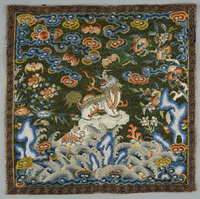
Dark blue silk satin embroidered with multicolored silk, gold-wrapped thread and peacock filament
-

Lotus and gold characters; yellow border
-

Yellow background, white rabbit and gold characters, black satin border
-
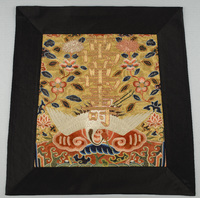
Manchurian crane and gold characters, black border
-

-

-

mustard yellow silk brocade embroidered in satin stitch
-
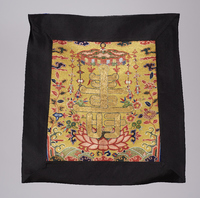
mustard yellow silk brocade embroidered in satin stitch
-

w/tassels
-

-

silk tassels
-

embroidery on red satin; figures in garden
-

crane in garden; embroidery on black
-

crane in garden; embroidery on black
-

crane in garden; embroidery on black
-
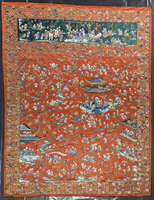
wedding gift, 100 children
-

<p>In Confucianism, the code of moral conduct associated with the teachings of the Chinese philosopher Confucius, or Kongzi <span lang="ZH-TW" style="font-family:"PMingLiU",serif">孔子</span>, 551-479 B.C.E., filial piety is the most important principle to regulate human relationships and maintain social order. Filial piety is defined as the humane and ethical behavior that should guide interactions among individuals, families, and members of every level of government, the healthy balance of which will result in a peaceful and harmonious society.</p>
<p>The <i>Classic of Filial Piety</i> (<i>Xiaojing</i> <span style="font-family:SimSun">孝經</span>), an anonymous text produced between the fourth and third century B.C.E., described proper behavior and became as influential in East Asia as sacred religious texts. The concept of filial piety was also promoted beyond Confucian doctrine: narratives of exemplary Buddhists touted their devotion to treating others with love and respect. Chinese stories about benevolence and loyalty express the deep-rooted conviction that a benevolent superior, whether ruler, official, or father, who does not abuse his power, but respects those in his care, will, in turn, enjoy the respect and obedience of his subjects and descendants.</p>
<p>During the Yuan dynasty (1260-1368), Guo Jujing (<span lang="ZH-TW" style="font-family:SimSun">郭居</span><span style="font-family:SimSun">敬</span>) composed an illustrated manual featuring stories from <i>Twenty-Four Paragons of Filial Piety</i> (<i>Ershisi Xiao</i><span lang="ZH-TW" style="font-family:SimSun">二十四孝</span>), which became the most prominent text used for teaching this concept. Designed to motivate the reader to emulate the behavior of virtuous individuals, the stories concentrate on the loyalty, obedience, and respect shown by those in the position of dependent.</p>
<p>In addition to the moral standards propagated in printed filial piety manuals, honor and respect for elders was often expressed at celebratory events, such as significant birthdays. The congratulatory paintings, wall hangings, and cards, and the festive attire worn on such occasions are often decorated with auspicious characters and images.</p>
<p>The selection of embroidered textiles depicting stories or scenes from the <i>Twenty-Four Paragons</i> included in this installation reflect the proliferation of the topic in Chinese literature and material culture. They are also included here as examples for various stitches of the exquisite embroideries in the Warner collection.</p>
-
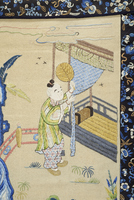
<p>In Confucianism, the code of moral conduct associated with the teachings of the Chinese philosopher Confucius, or Kongzi 孔子, 551-479 B.C.E., filial piety is the most important principle to regulate human relationships and maintain social order. Filial piety is defined as the humane and ethical behavior that should guide interactions among individuals, families, and members of every level of government, the healthy balance of which will result in a peaceful and harmonious society.</p>
<p>The <i>Classic of Filial Piety</i> (<i>Xiaojing</i> 孝經), an anonymous text produced between the fourth and third century B.C.E., described proper behavior and became as influential in East Asia as sacred religious texts. The concept of filial piety was also promoted beyond Confucian doctrine: narratives of exemplary Buddhists touted their devotion to treating others with love and respect. Chinese stories about benevolence and loyalty express the deep-rooted conviction that a benevolent superior, whether ruler, official, or father, who does not abuse his power, but respects those in his care, will, in turn, enjoy the respect and obedience of his subjects and descendants.</p>
<p>During the Yuan dynasty (1260-1368), Guo Jujing (郭居敬) composed an illustrated manual featuring stories from <i>Twenty-Four Paragons of Filial Piety</i> (<i>Ershisi Xiao</i>二十四孝), which became the most prominent text used for teaching this concept. Designed to motivate the reader to emulate the behavior of virtuous individuals, the stories concentrate on the loyalty, obedience, and respect shown by those in the position of dependent.</p>
<p>In addition to the moral standards propagated in printed filial piety manuals, honor and respect for elders was often expressed at celebratory events, such as significant birthdays. The congratulatory paintings, wall hangings, and cards, and the festive attire worn on such occasions are often decorated with auspicious characters and images.</p>
<p>The selection of embroidered textiles depicting stories or scenes from the <i>Twenty-Four Paragons</i> included in this installation reflect the proliferation of the topic in Chinese literature and material culture. They are also included here as examples for various stitches of the exquisite embroideries in the Warner collection.</p>
-

<p>In Confucianism, the code of moral conduct associated with the teachings of the Chinese philosopher Confucius, or Kongzi 孔子, 551-479 B.C.E., filial piety is the most important principle to regulate human relationships and maintain social order. Filial piety is defined as the humane and ethical behavior that should guide interactions among individuals, families, and members of every level of government, the healthy balance of which will result in a peaceful and harmonious society.</p>
<p>The <i>Classic of Filial Piety</i> (<i>Xiaojing</i> 孝經), an anonymous text produced between the fourth and third century B.C.E., described proper behavior and became as influential in East Asia as sacred religious texts. The concept of filial piety was also promoted beyond Confucian doctrine: narratives of exemplary Buddhists touted their devotion to treating others with love and respect. Chinese stories about benevolence and loyalty express the deep-rooted conviction that a benevolent superior, whether ruler, official, or father, who does not abuse his power, but respects those in his care, will, in turn, enjoy the respect and obedience of his subjects and descendants.</p>
<p>During the Yuan dynasty (1260-1368), Guo Jujing (郭居敬) composed an illustrated manual featuring stories from <i>Twenty-Four Paragons of Filial Piety</i> (<i>Ershisi Xiao</i>二十四孝), which became the most prominent text used for teaching this concept. Designed to motivate the reader to emulate the behavior of virtuous individuals, the stories concentrate on the loyalty, obedience, and respect shown by those in the position of dependent.</p>
<p>In addition to the moral standards propagated in printed filial piety manuals, honor and respect for elders was often expressed at celebratory events, such as significant birthdays. The congratulatory paintings, wall hangings, and cards, and the festive attire worn on such occasions are often decorated with auspicious characters and images.</p>
<p>The selection of embroidered textiles depicting stories or scenes from the <i>Twenty-Four Paragons</i> included in this installation reflect the proliferation of the topic in Chinese literature and material culture. They are also included here as examples for various stitches of the exquisite embroideries in the Warner collection.</p>
-

<p>In Confucianism, the code of moral conduct associated with the teachings of the Chinese philosopher Confucius, or Kongzi 孔子, 551-479 B.C.E., filial piety is the most important principle to regulate human relationships and maintain social order. Filial piety is defined as the humane and ethical behavior that should guide interactions among individuals, families, and members of every level of government, the healthy balance of which will result in a peaceful and harmonious society.</p>
<p>The <i>Classic of Filial Piety</i> (<i>Xiaojing</i> 孝經), an anonymous text produced between the fourth and third century B.C.E., described proper behavior and became as influential in East Asia as sacred religious texts. The concept of filial piety was also promoted beyond Confucian doctrine: narratives of exemplary Buddhists touted their devotion to treating others with love and respect. Chinese stories about benevolence and loyalty express the deep-rooted conviction that a benevolent superior, whether ruler, official, or father, who does not abuse his power, but respects those in his care, will, in turn, enjoy the respect and obedience of his subjects and descendants.</p>
<p>During the Yuan dynasty (1260-1368), Guo Jujing (郭居敬) composed an illustrated manual featuring stories from <i>Twenty-Four Paragons of Filial Piety</i> (<i>Ershisi Xiao</i>二十四孝), which became the most prominent text used for teaching this concept. Designed to motivate the reader to emulate the behavior of virtuous individuals, the stories concentrate on the loyalty, obedience, and respect shown by those in the position of dependent.</p>
<p>In addition to the moral standards propagated in printed filial piety manuals, honor and respect for elders was often expressed at celebratory events, such as significant birthdays. The congratulatory paintings, wall hangings, and cards, and the festive attire worn on such occasions are often decorated with auspicious characters and images.</p>
<p>The selection of embroidered textiles depicting stories or scenes from the <i>Twenty-Four Paragons</i> included in this installation reflect the proliferation of the topic in Chinese literature and material culture. They are also included here as examples for various stitches of the exquisite embroideries in the Warner collection.</p>
























